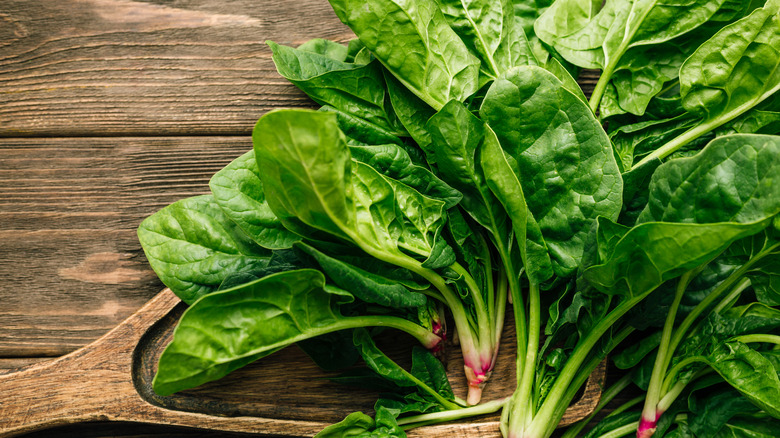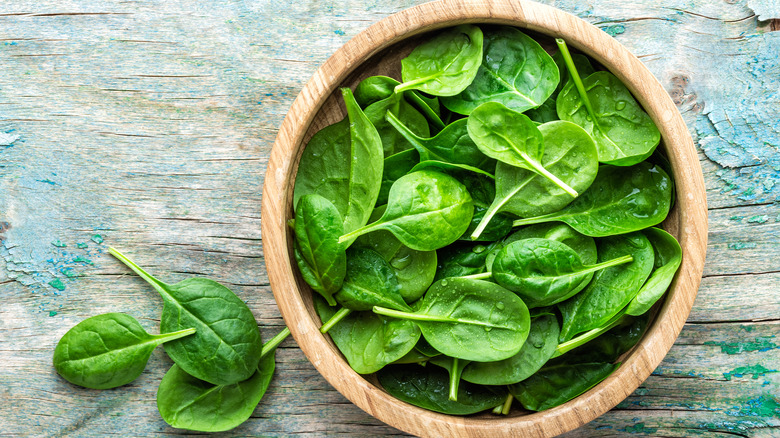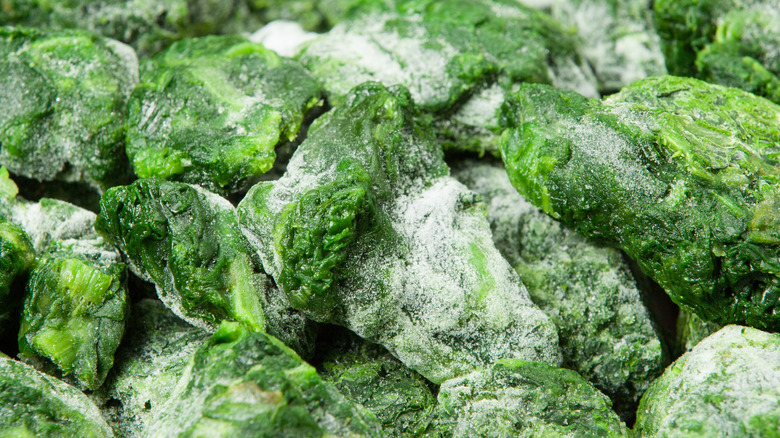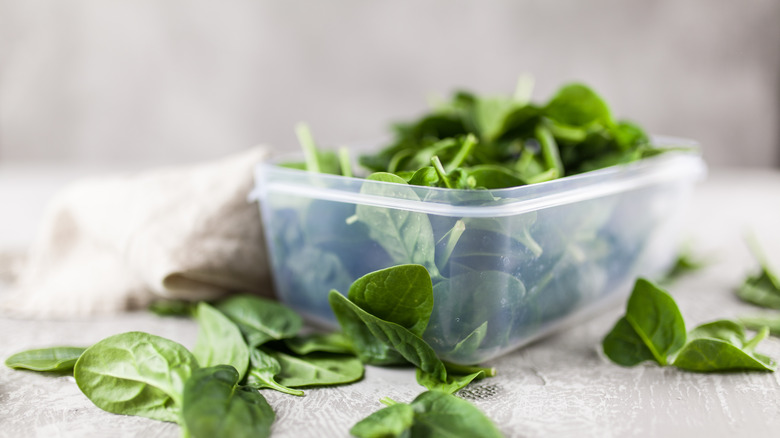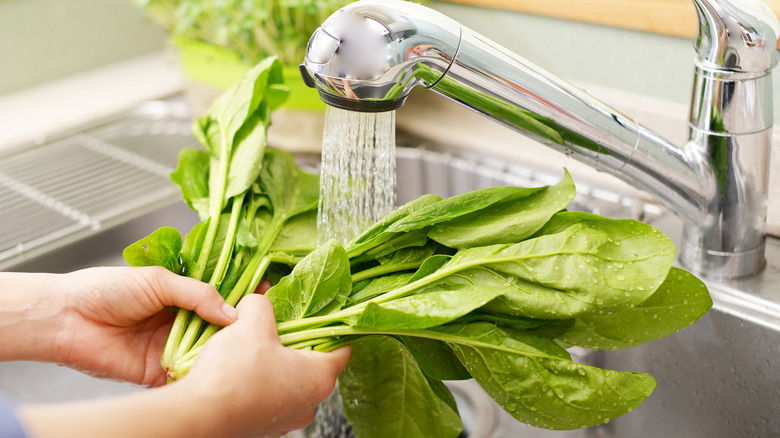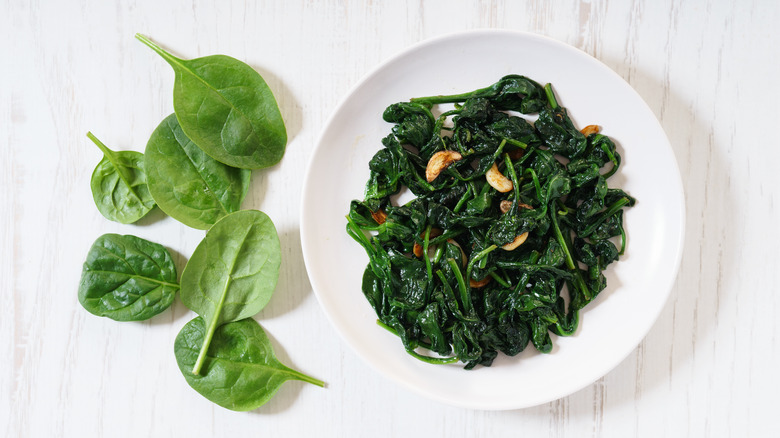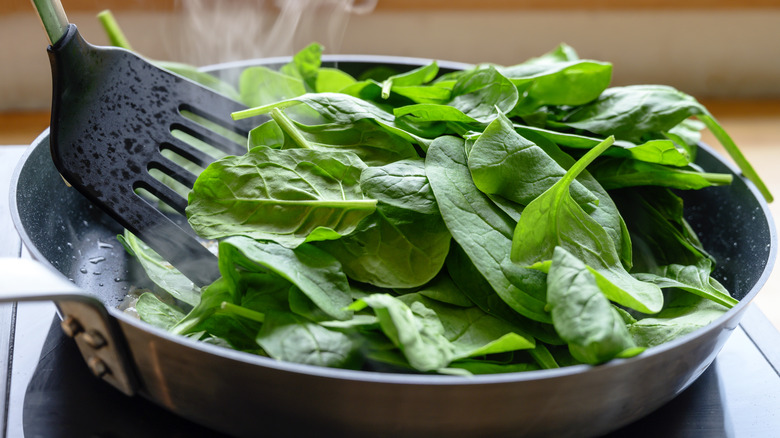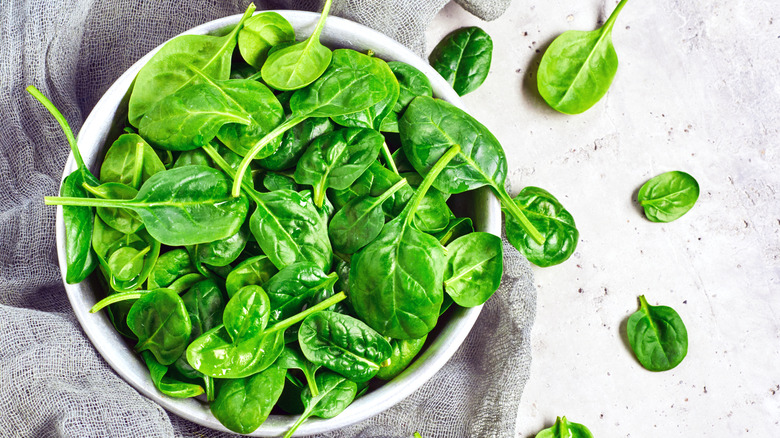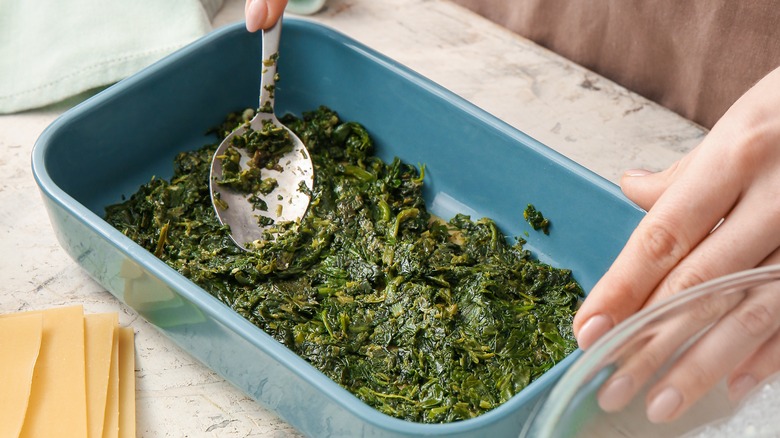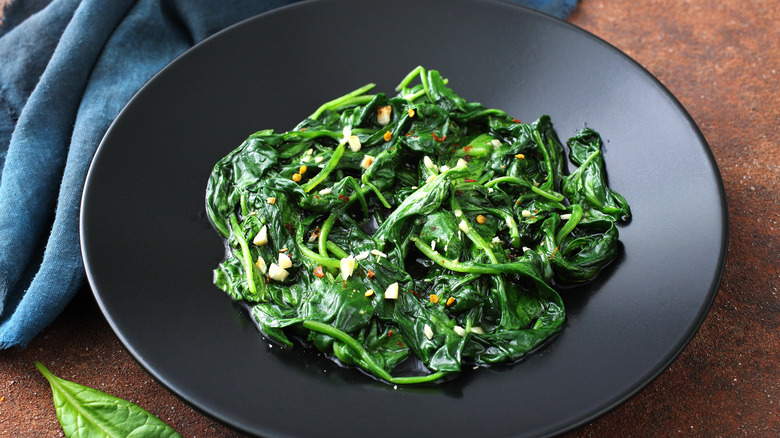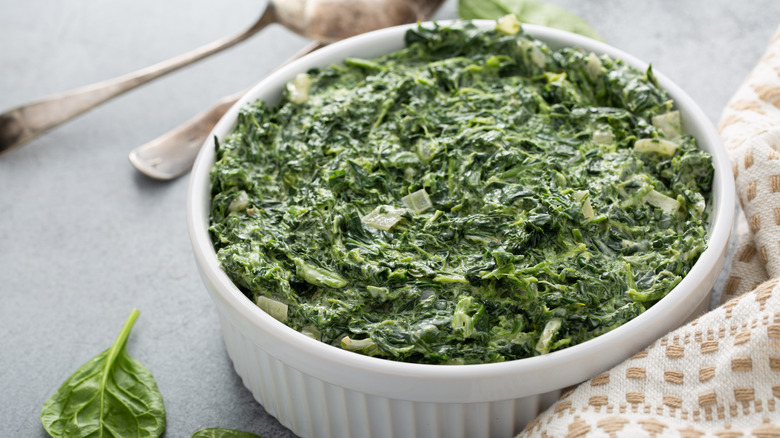Mistakes Everyone Makes While Cooking Spinach
From the time it was first cultivated thousands of years ago, spinach has been on quite the rollercoaster ride. In its earliest days, it was reserved for royalty and the upper class (there's even a 16th-century queen of France rumored to have eaten it with every meal). Fast forward to more recent history, and it booms during times of financial crisis — for example, during the Great Depression (even kids listed spinach as their third favorite vegetable in the 1930s, as reported by the University of Missouri Extension) and again in 2020 at the height of the COVID-19 pandemic, according to the Vegetarian Times.
All the while, spinach has remained an incredibly nutrient-rich green just waiting to be added to your plate. Nevertheless, public opinion tends to be divided. You either love it or you hate it. If you fall into the "hate it" camp, we're here to let you in on a secret: you might just be cooking it wrong. Here are the most common mistakes people make when cooking spinach, plus easy ways to avoid them. You might just change your mind!
Reaching for the baby spinach
Baby spinach is great. Eat it raw any time you want — just don't add it to your skillet, put it in the oven, or use it in any other recipe that requires heat. For that, you want mature spinach, which are those dark green, leafy bunches you see at the store or farmers' market. You might have to look a little bit harder to find it, as most spinach at the store is the baby stuff, but trust us when we say it will be worth it.
That's because the very qualities baby spinach is prized for when eaten raw (tender leaves with a delicate flavor) results in it breaking down too quickly when it's cooked, leaving you with a slimy mess. Mature spinach, on the other hand, has a more robust flavor and texture that stands up to cooking without losing too much structure or becoming soggy. Bon Appetit explains it performs much better in heat-requiring recipes, like sautéed spinach, soups, pasta sauces, and more.
Refusing to use frozen spinach
If you can't find raw mature spinach, Bon Appetit says frozen has the same flavor and texture, and it's just as nutrient-rich as fresh. Martha Stewart gets behind this hack, too, and notes frozen spinach is picked and frozen at its peak so it's always "in season." Frozen vegetables are typically flash frozen, a process invented in the 1920s by the founder of Birds Eye (the No. 1 producer of frozen veggies in the United States). It freezes vegetables so fast their cell walls can't be damaged. This preserves their texture, flavor, color, and nutrients so well that their quality can be better than fresh.
Another benefit to frozen spinach is that it comes pre-blanched. Blanching vegetables by cooking them very quickly in boiling water preserves nutrients, texture, and flavor, and helps you get that perfectly cooked spinach recipe every time. Even if you're using fresh spinach, we recommend taking the extra step. It's quick, and a trick we swear by for the ultimate creamed spinach. You can also blanch spinach to make it easier to freeze yourself, as outlined by Simply Canning. This is especially useful if you find mature spinach and want to stock up while you can.
Storing spinach incorrectly before it's cooked
If you've ever grabbed spinach from your fridge (that you swear you just bought) and been met with a slimy, wilted mess, you know how quickly it can go bad. Like many leafy greens, its high water content and delicate structure leave it particularly prone to spoiling. The best way to help it stay fresh longer than a day is to make sure it stays thoroughly dry. MyRecipes recommends picking out any leaves that have already yellowed or gone bad and rinsing the remaining spinach. Afterward, pat it dry with a paper towel. Once every single spinach leaf is dry, it's best to store it in an airtight container or salad spinner lined with more paper towels to soak up any moisture you missed. Kept in the refrigerator this way, spinach should stay good for up to a week.
Oh, and if your spinach does become soggy, yellow around the edges, and a little bit smelly, you'll probably want to go ahead and toss it. Just file these tips away for next time!
Failing to rinse
If you buy pre-bagged spinach, it's probably already been washed (it will typically say so on the bag), but if you're getting it fresh, you'll want to rinse it before cooking. Rinsing veggies (and fruits) helps wash away bacteria that could make you sick, along with residue left over from farming or processing (dirt, pesticides, etc.). Just wait to rinse your spinach until right before it's ready to cook. Otherwise, your greens will go bad faster if you continue storing them in the fridge.
While you might see products made specifically for washing produce, water works just as well. Research conducted at the University of Maine indicates that soaking produce for a minute or two in distilled water works just as well as soaking it in the produce wash (and better than washing it with an ozone wash). Speaking of soaking, though, the Centers for Disease Control and Prevention (CDC) actually recommends rinsing under running water — which is great since that's even easier than a soak! Make sure your spinach is completely dried off before you cook it to keep it from getting soupy.
Not using enough spinach
Chances are you've seen at least one meme about the mysterious vanishing act spinach pulls every time you add it to a pan. The science behind this illusion is a rapid and drastic loss of water. According to data published in Nutrition Review, spinach is more than 90% water, so it's no surprise it shrinks so much when you cook it as that water evaporates away.
Keep that in mind when you're cooking with spinach and add a heck of a lot more to the pan than what you hope to end up with in the end. Taste of Home actually recommends using 10 to 12 cups of fresh, torn spinach leaves for every one cup of cooked spinach you want to have at the end. If you're using frozen spinach, one 10-ouce package should cook down to about a cup and a half.
It's interesting to note that since some vitamins are water soluble (meaning they dissolve when they meet it), the water loss spinach experiences when it's cooked means it loses a little bit of its vitamin C. On the flip side, boiling spinach makes its iron and calcium easier to absorb – so you win some, you lose some.
Not adding extra vitamin C
Have you heard the one about the scientist and the decimal point? Let us elaborate. While spinach does have iron in it, it was once thought to be a much richer source. Based on a story described in the British Medical Journal in 1972, a scientist researching the iron content of spinach accidentally put a decimal point in the wrong place back in the 1870s. Until that was realized, it made it look like spinach had 10 times more iron than it really does!
Although it might not be the mega source of iron it was once thought to be, 1 cup of raw spinach does have 0.813 mg of iron. Additionally, 1 cup of cooked spinach (which, remember, takes more like 10 cups of raw spinach to start) has 3.72 mg of iron. That's 4.5% and 20% of the recommended daily value for iron respectively, per the U.S. Food and Drug Administration, which is nothing to sneeze at. You can increase the absorption of that iron by eating it along with vitamin C, as explained by MedicalNewsToday. That's why serving spinach alongside foods rich in this antioxidant vitamin, like with a squeeze of lemon atop sautéed spinach or peppers and tomatoes in a salad, is a great way to get the most nutritional bang for your buck.
Overcooking your spinach
We can't say this enough: spinach cooks very quickly. If you're making spinach by itself, the key is to cook it high and fast as opposed to low and slow. If you're sautéing it, turn up the heat and cook the spinach in a little bit of hot oil for only about 3 minutes (until it's barely wilted). Leave the lid off and stir frequently so the water the spinach releases as it cooks can evaporate. Otherwise, you run the risk of letting the spinach stew in too much liquid. This can be good in its own right, but dilutes the bright, fresh test you're often looking for with sautéed spinach.
You can also cook your spinach quickly by blanching it before mixing it into recipes like creamed spinach or quiche. Just boil some water, add the spinach leaves, and let them cook for about 30-40 seconds before transferring the spinach to a bowl of ice water to halt the cooking process. MyRecipes notes you can also blanch spinach before you freeze it to help it hold up to the cold. This is a great way to prevent having to throw away any fresh spinach you don't think you'll use before it goes bad.
Not using the colander trick
The internet is a treasure trove of food hacks, and one of our favorites is the perfect solution to overcooked spinach — let's call it the colander trick. The best way to avoid exposing your spinach to too much heat is to avoid letting it touch the stove at all. Instead of submerging your spinach in boiling water on the stove or exposing it to the direct heat of a hot pan, put it all into a colander and slowly, carefully pour boiling water over the top.
Since the water drains through the colander, the spinach is only exposed to heat for a short amount of time. It wilts (or cooks) quickly and instead of overcooking or becoming waterlogged. The spinach you get is bright and perfectly tender every time. If you don't already have a colander, this is just one of many reasons to invest. They're good to have on hand for everything from washing veggies to steaming them.
Crowding the spinach while it's cooling
By now, you know that all it takes to cook spinach is basically a little steam, so you can imagine what might happen if you cool it in a big pile — it keeps cooking. The steam from the spinach on the bottom will travel up through the spinach above and continue cooking it, ruining the perfectly tender leaves you tried so carefully to time during your sautéing, steaming, or blanching.
That's why The Kitchn recommends spreading cooked spinach out on a cookie sheet or plate (tongs can help with this part) to let it cool in a single layer. This will help prevent it from overcooking. You can also use a silicone baking sheet, like the one Aldi shoppers love, or use a sheet of parchment paper. Putting down parchment paper first — even on top of your baking sheets — will allow you to easily slide the spinach off onto your plate when it's ready to go.
Skipping the squeeze
Even if you do everything you can to minimize the wateriness of your spinach while it cooks (thoroughly dry it beforehand, cook it quickly at high heat, stir it to release steam, and cool it in a single layer), there's still going to be some water left. If you're planning to incorporate it into another recipe like lasagna, spanakopita, or quiche, you'll want to give it a squeeze.
Wringing the excess water from your cooked spinach is essential, and there are several ways to do it — and several ways not to. Let's start with the latter. Don't use a dish towel unless you want it to turn out tie-dyed, and skip the paper towel to avoid spending several aggravating minutes picking tiny pieces out when you're done. The easiest way to do it correctly is to throw it in a colander and gently depress it with your hand until most of the water has drained away (just make sure it's cool enough to touch, first). If you happen to have a sushi mat or potato ricer, it's even easier and you don't need to touch the spinach much at all. Place your sushi mat on a rimmed baking sheet to catch the water as it drains, lay the spinach across it, and roll it up. You can also put the spinach in your potato ricer and squeeze over a bowl.
Failing to flavor it
If you turn up your nose at spinach (or did as a kid), it could be because the spinach you've eaten has lacked sufficient flavor. Spinach can be a little bland on its own, but it's the perfect canvas for adding flavor, so don't be too stingy with the salt and pepper! Garlic goes very well with spinach, too. A Couple Cooks recommends sautéing garlic with a few whole garlic cloves to give it a subtle kick of flavor throughout, and we love Rachael Ray's recipe for wilting spinach in garlic and oil.
The possibilities don't stop at sautéed spinach, either. While that's definitely a common (and easy) way to make it, spinach is also the star ingredient in recipes that seem a bit more complex, from creamed spinach with caramelized onions and garlic in a thick, butter-based roux to rigatoni fiorentina, a pasta dish that combines creamy tomatoes, melty mozzarella cheese, and a heaping helping of spinach. Give them a try, and you might be surprised by how easy they actually are to make (especially compared to how fancy they taste).
